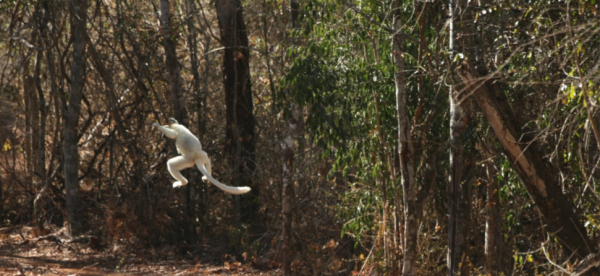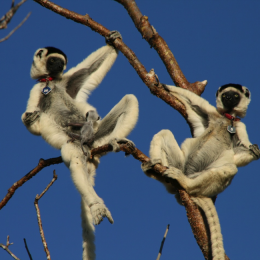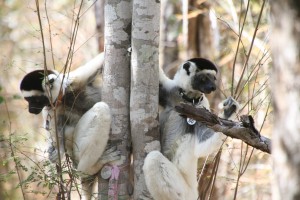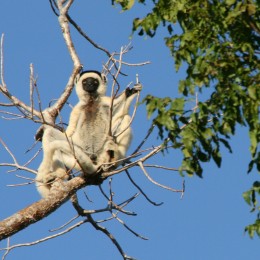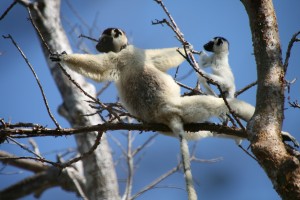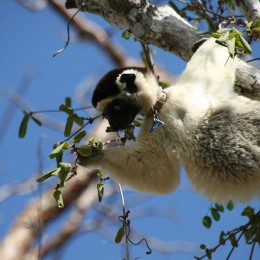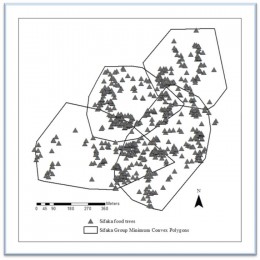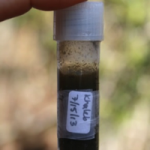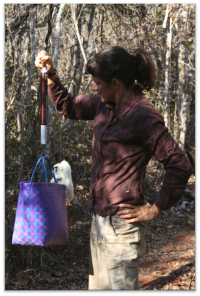Sifaka Research Project
Verreaux’s sifaka (Propithecus verreauxi) is a medium-sized (3 – 4 kg) diurnal primate that is found in the dry forests, gallery forests, and spiny deserts throughout the west and southwest of Madagascar. The conservation status has recently changed from vulnerable to endangered due to extensive and ongoing habitat destruction.
Sifaka use a form of locomotion called vertical clinging and leaping.
Dr. Rebecca Lewis began the Sifaka Research Project, a long-term study of the sifaka in the Kirindy Mitea National Park, in 2006. The goal of this project is to understand the behavior, demography, ecology, genetics, health, and morphology of the species. Multiple groups within the Ankoatsifaka Research Station have been habituated to human presence and marked with nylon collars and tags or radio collars for swift location and easy identification. Much of the research is conducted in collaboration with other researchers. If you are interested in getting involved with this project as a collaborator or volunteer, or if you are interested in donating money to support this long-term study, click here.
Behavior
The Sifaka Research Project aims to understand the nature of sifaka social relationships and the power dynamics within sifaka societies as well as their behavioral ecology. Sifaka exhibit a number of interesting social behaviors, such as social grooming, coalitions, redirected aggression, and formalized dominance. Females have more social power than males (“female dominance”).
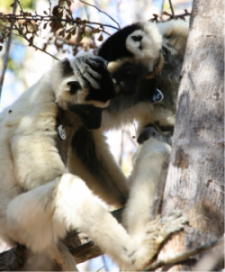
Adult female sifaka with infant nursing is aggressive towards adult male who has been repeatedly attempting to groom the new baby.
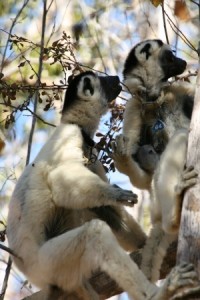
The sifaka male communicates submission with a chatter vocalization after receiving aggression from the adult female.
Four social groups are the primary focus of the behavioral research.
We are also examining sifaka reproductive strategies. Sifaka males have two forms: stained and clean-chested. These different male morphs are associated with alternative mating tactics. The stained males have higher testosterone and are the dominant male or the only adult male in the social group. The clean-chested males are subordinate and sometimes more peripheral to the social group. A male’s relationship with females depends on his chest status. Stained males attempt to mate guard the females. Females are more tolerant of the clean-chested males than stained males.
Demography and Life History
Sifaka live in cohesive social groups of 2-14 individuals. Males usually leave their natal groups as subadults (3-4 years old). They sometimes transfer directly into a neighboring social group or may travel longer distances. They can disperse by themselves or with another male, such as a brother. Female sifaka may also leave their natal groups, but female dispersal is much less common. The Sifaka Research Project conducts monthly censuses of the social groups located within the study area. Because many of the individuals wear collars and tags, we are able to reliably track individuals throughout their lives. In addition to dispersal patterns, we are able to examine sifaka life history patterns, such as interbirth intervals, infant survival, age at weaning, and age of first reproduction.
Ecology
Sifaka are mostly folivorous (leaf eaters), but also eat fruit, seeds, flowers, buds, and bark. We are currently studying the sifaka diet and the distribution of their food resources in the forest. Over 12,000 of their food trees, shrubs, and vines have been marked, identified, and measured. We are using these data to examine foraging and travel decisions.
Genetics
Genetic samples have been collected from all study subjects. While initially we collected small tissue samples from sedated sifaka, new techniques allow us to collect genetic material noninvasively via fecal samples. We are using the DNA to determine the relatedness of individuals, dispersal patterns, and variation in visual abilities.
Health
In collaboration with wildlife veterinarians, we have been studying the general health of the population. We have published the first baseline biomedical evaluation for Verreaux’s sifaka. Additionally, we are modeling sifaka social networks to see how social interactions influence the spread of disease.

Student Felana Rakotondranaivo assists wildlife veterinarian Dr. Fidy Rasambainarivo collect blood from a sifaka in order to assess the health of the population.
Morphology
Because we capture animals periodically to mark them with (and replace) collars, monitor health, and collect genetic material, we use this opportunity to collect morphological measurements, such as body weight, body length, and canine size.
